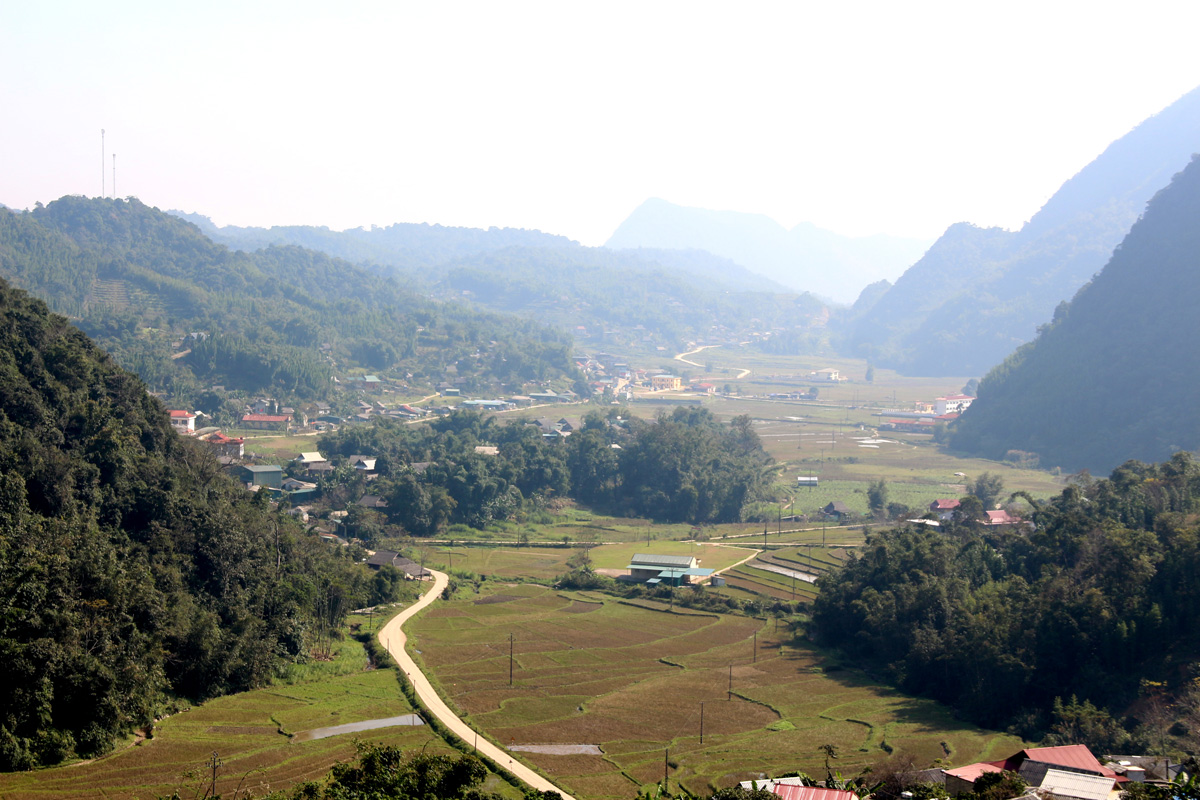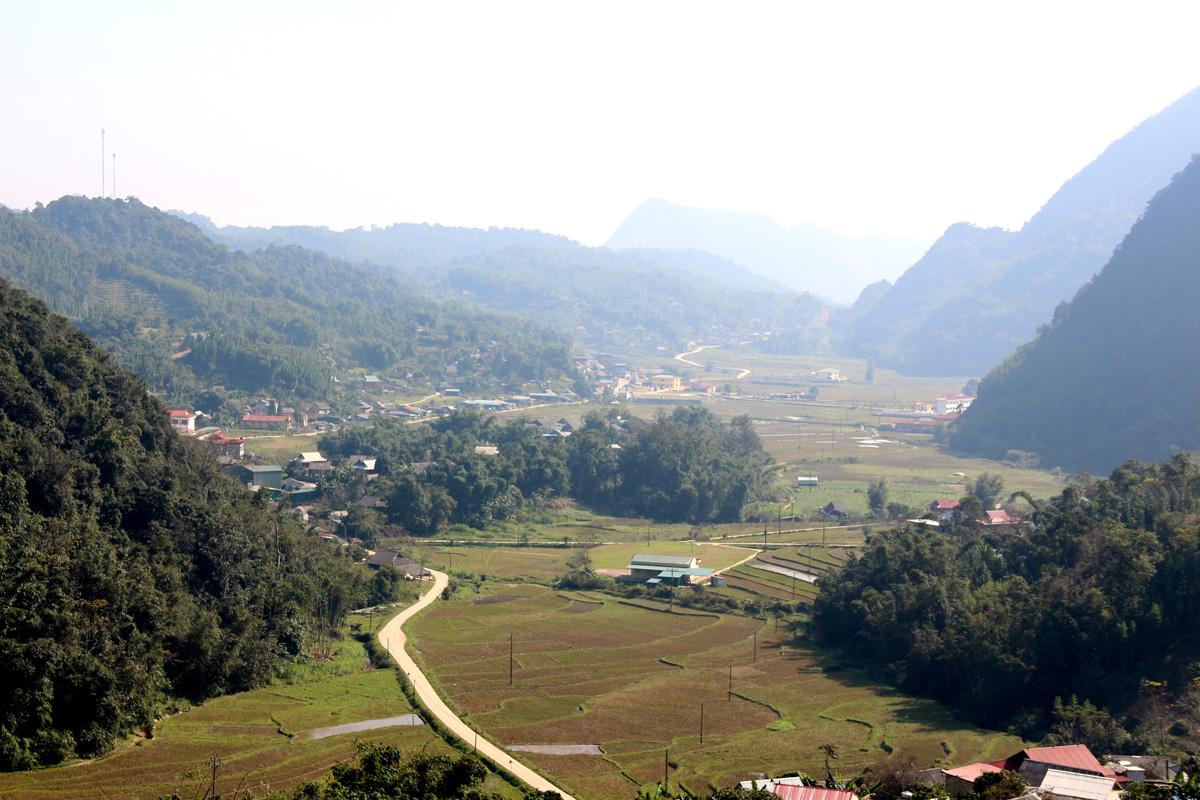



The beautiful natural landscape and preserved traditional cultural values are an important foundation for the highland communes of Tan Lac district to develop tourism. Photo: Van Son commune center viewed from above.
Concentrating the efforts to turn the "roof” of Muong Bi into a provincial-level tourism area
It has been several years since I returned to the "roof” of Muong Bi. The natural scenery and people are still the same. It is still the beautiful nature with majestic, long green mountain ranges. The traditional cultural identity of the nation has been preserved for generations, the native people are simple, hard-working, and diligent... However, the life has changed with many bright colors. The place considered the "roof” of Muong Bi includes the communes: Quyet Chien, Van Son, and Ngo Luong. With an average altitude of 800 - 1,000m above the sea level, these communes have a high forest coverage rate, cool and mild climate. This place still preserves many traditional and ancient cultural values of Muong ethnic people.
According to Mr. Le Chi Huyen, the Vice Chairman of Tan Lac District’s People's Committee, implementing Resolution No. 13-NQ/TU, the district and departments and branches have initially implemented and achieved the certain results. The capital sources of the national target programs have been concentrated and integrated to implement the goals and tasks gradually. In particular, the district has promoted propaganda to raise the people's awareness in preserving and promoting the nation's fine traditional cultural values to create products for tourism development. At the same time, each commune has selected one hamlet to build community tourism sites. In particular, Van Son commune has selected Hay Duoi hamlet; Quyet Chien commune has selected Bac Thung hamlet, Ngo Luong commune has selected Luong Ca hamlet. Along with that, the district and the province have paid the special attention to investing in developing the integrated transport infrastructure with connecting routes, attracting investment to serve the development of tourism, services, and trade of the province in general and the highland communes of the district in particular.
In addition, the district has increased investment in infrastructure to serve the development of synchronous and quality tourism, such as upgrading accommodation facilities, event spaces, cultural and artistic performances, and tourism destinations in the places with beautiful landscapes; encouraging the households to invest in community tourism associated with promoting the traditional cultural values; providing the direct support to the families to build homestay accommodation services; allocating resources from the National Target Program to support the construction of art groups; providing equipment for 9 cultural houses in the residential areas of communes. Developing tourism human resources has been paid attention to, the training courses have been to raise awareness of tourism for nearly 300 households in hamlets selected as community tourism sites and the people in 3 communes.
It is difficult to turn the "roof: of Muong Bi into a "miniature Sapa”
The three highland communes are identified as areas with great potential for tourism development. In addition to the system of beautiful landscapes and caves ranked as provincial and national relics such as Nam Son Cave, Nui Kien Cave, there are also many tourist attractions such as Lung Van Peak covered with clouds all year round, Lung Van terraced fields, Thung waterfall... The community also preserves many traditional cultural values of Muong people such as ancient stilt houses, costumes, fine customs, traditional festivals, Mo Muong performances, folk songs, folk games, cuisine... The above resources are an important foundation for developing ecotourism, community tourism, experiential tourism and discovery tourism. In addition, the communes also have the potential to develop agricultural tourism, with the areas producing highland specialty, agricultural products such as the hill of Nam Son ancient tangerine, Quyet Chien chayote valley, Bac Son purple garlic, Quyet Chien off-season vegetables and fruits, herbs, wild vegetables, snow tea...
Promoting the potentials and advantages, the tourism activities in the area have achieved some remarkable results, the income from community tourism services has contributed to improving the people's lives; the village roads and alleys are cleaned and beautified; the lifestyles and the cultures of behavior are friendly and hospitable; the cultural identity and the images of the land and people in highland communes are promoted and spread; many agricultural products are introduced and sold to visitors…
However, according to the assessment, the above results are only the "bright spots” in the general picture of the highland communes. As being localities with difficult socio-economic conditions, the starting point is still limited, especially in terms of traffic infrastructure and socio-cultural institutions. Currently, tourists can reach the highland communes by many different routes, but most of them are difficult to travel, especially since the main route from National Highway 6 has not been invested in or upgraded for a long time, causing difficulties for travel, especially for large passenger vehicles. The lives of the majority of people are still difficult; the exploitation of agricultural and forestry land funds is not effective, the people are still struggling with the solution to the problem of what to raise, what to plant...
From that reality, the aspiration to turn the "roof” of Muong Bi into a "Sapa of Muong land” with the nearest goal by 2025, trying to welcome 50 thousand turns of tourists (about 5 thousands of turns of international visitors) with about 30 thousand turns of overnight visitors; the social revenue from tourism reaches about 30 billion VND. It is necessary to attract great investors to develop high-end resorts, trying to have at least 1 high-end resort meeting 3-5 star standards put into operation, with a scale of 50-60 rooms; having about 20-30 homestay businesses. It is hoped to create jobs for about 750 local employees, of which there are about 250 direct employees are considered difficult to become a reality.
For the goal of welcoming 115,000 turns of tourists (about 15,000 turns of international visitors) by 2030, the number of visitors reach about 70,000 turns; the social revenue from tourism is about 100 billion VND. There will be 3-4 high-end resorts meeting 3-5 star standards with a scale of 150-200 rooms; there will be about 40-50 homestay businesses, providing about 800-1,000 beds to serve tourists. Creating employment for about 2,500 local employees is also considered a distant goal in the context of difficult infrastructure investment capacity, requiring a huge concentration of resources...